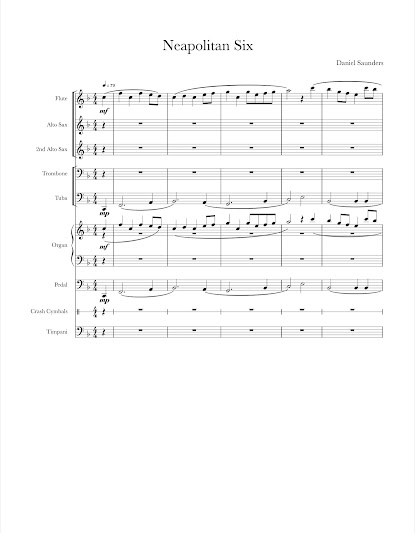Neapolitan Six
Lesson 32
February 18th, 2022
Lesson 32
Lecture notes:
- The Neapolitan six is when you take the second degree of a diatonic scale, whether major or minor, lower the root note, and put the said chord in the first inversion. I'll give an example using an F major scale with and without the Neapolitan Six. Without I (F, A ,C), ii (G, Bb, D), iii (A, C, E) IV (Bb, D, F), V (C, E, G), vi (D, F, A), viio (E, G, Bb), I (F, A, C). With I (F, A, C), bII6 (Gb, *Bb, Db), iii (A, C, E) IV (Bb, D, F), V (C, E, G), vi (D, F, A), viio (E, G, Bb), I (F, A, C).
- Lowering the root note in the second-degree triad of the diatonic scale turns it from a diminished chord to a major chord.
- The Neapolitan six is a pre-dominant chord and mostly always precedes a dominant chord.
- The two chords that function as the dominant are chords five and seven because they have the leading tone note.
- The six in Neapolitan six represents the 6 in a lead sheet symbol indicating the first inversion.
- The formal lead sheet symbol or Roman numeral for the Neapolitan six on a piece of music would be N6.
- The flat 2 should only move up chromatically to the natural 2 in the inner voices. This should never be done in the soprano voice.
- The bass note should be the only note you double in the Neapolitan six chord to avoid voice-leading issues and potential parallels,
- The Neapolitan six can be tonicized and is usually in root position for this feature instead of being in first inversion.
- The secondary dominant or secondary leading tone chord must contain the appropriate accidentals to stay true to the tonal center of the tonicized Neapolitan six whenever you decide to implement this feature.
The photo above shows a Neapolitan six in the key of A minor. The chord in question (Bb) is represented by the N6 and precedes the dominant. The chord is also in the first inversion as the bass note is D. Photo Credit: (https://musicstudent101.com/61-the-neapolitan-chord.html)
The photo above shows an example of the Neapolitan six chord in C major and C minor. You can see where both chords had the root note lowered to create a major chord from its original diminished form, respectively. Photo Credit: Komponist (http://musictheoryblog.blogspot.com/2016/08/neapolitan-chords.html)
The video above explains what a Neapolitan six chord is, how it is constructed, where it originated from, and the practicality behind its use. The presenter used visual aids and short excerpts from various composers to aid in his presentation. Video Credit: Creatively eXplained (https://www.youtube.com/watch?v=_0fWoa5jUBM)
The video above explains what a Neapolitan six chord is and how to construct it. The presenter uses the piano to aid in his lesson and uses the key of C major to illustrate the formula of the Neapolitan six chord. Video Credit: LivingPianosVideos (https://www.youtube.com/watch?v=wAmkg6wtAc4)
This is the midi recording for the composition that I wrote.











Comments
Post a Comment